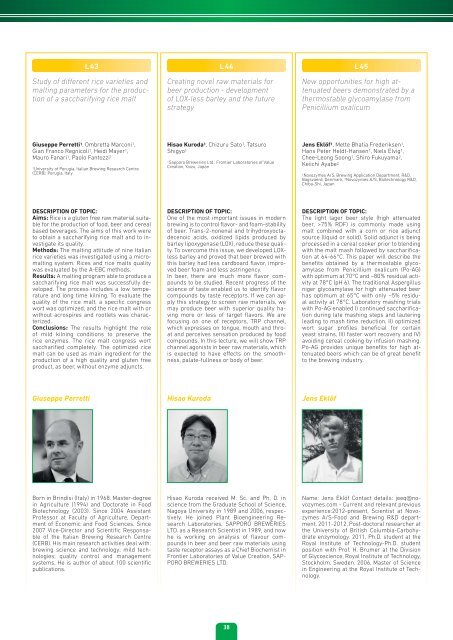please click here for download. - the 34th European Brewery ...
please click here for download. - the 34th European Brewery ...
please click here for download. - the 34th European Brewery ...
You also want an ePaper? Increase the reach of your titles
YUMPU automatically turns print PDFs into web optimized ePapers that Google loves.
L 43<br />
Study of diff erent rice varieties and<br />
malting parameters <strong>for</strong> <strong>the</strong> production<br />
of a saccharifying rice malt<br />
Giuseppe Perretti 1, Ombretta Marconi 1,<br />
Gian Franco Regnicoli 1, Heidi Mayer 1,<br />
Mauro Fanari 1, Paolo Fantozzi 1<br />
1University of Perugia, Italian Brewing Research Centre<br />
(CERB), Perugia, Italy<br />
DESCRIPTION OF TOPIC:<br />
Aims: Rice is a gluten free raw material suitable<br />
<strong>for</strong> <strong>the</strong> production of food, beer and cereal<br />
based beverages. The aims of this work were<br />
to obtain a saccharifying rice malt and to investigate<br />
its quality.<br />
Methods: The malting attitude of nine Italian<br />
rice varieties was investigated using a micromalting<br />
system. Rices and rice malts quality<br />
was evaluated by <strong>the</strong> A-EBC methods.<br />
Results: A malting program able to produce a<br />
saccharifying rice malt was successfully developed.<br />
The process includes a low temperature<br />
and long time kilning. To evaluate <strong>the</strong><br />
quality of <strong>the</strong> rice malt, a specifi c congress<br />
wort was optimized, and <strong>the</strong> rice malt with or<br />
without acrospires and rootlets was characterized.<br />
Conclusions: The results highlight <strong>the</strong> role<br />
of mild kilning conditions to preserve <strong>the</strong><br />
rice enzymes. The rice malt congress wort<br />
saccharifi ed completely. The optimized rice<br />
malt can be used as main ingredient <strong>for</strong> <strong>the</strong><br />
production of a high quality and gluten free<br />
product, as beer, without enzyme adjuncts.<br />
Giuseppe Perretti<br />
Born in Brindisi (Italy) in 1968. Master-degree<br />
in Agriculture (1994) and Doctorate in Food<br />
Biotechnology (2003). Since 2004 Assistant<br />
Professor at Faculty of Agriculture, Department<br />
of Economic and Food Sciences. Since<br />
2007 Vice-Director and Scientifi c Responsable<br />
of <strong>the</strong> Italian Brewing Research Centre<br />
(CERB). His main research activities deal with:<br />
brewing science and technology; mild technologies;<br />
quality control and management<br />
systems. He is author of about 100 scientifi c<br />
publications.<br />
L 44<br />
Creating novel raw materials <strong>for</strong><br />
beer production - development<br />
of LOX-less barley and <strong>the</strong> future<br />
strategy<br />
Hisao Kuroda 1, Chizuru Sato 1, Tatsuro<br />
Shigyo 1<br />
1Sapporo Breweries Ltd., Frontier Laboratories of Value<br />
Creation, Yaizu, Japan<br />
DESCRIPTION OF TOPIC:<br />
One of <strong>the</strong> most important issues in modern<br />
brewing is to control fl avor- and foam-stability<br />
of beer. Trans-2-nonenal and trihydroxyoctadecenoic<br />
acids, oxidized lipids produced by<br />
barley lipoxygenase (LOX), reduce <strong>the</strong>se quality.<br />
To overcome this issue, we developed LOXless<br />
barley and proved that beer brewed with<br />
this barley had less cardboard fl avor, improved<br />
beer foam and less astringency.<br />
In beer, t<strong>here</strong> are much more fl avor compounds<br />
to be studied. Recent progress of <strong>the</strong><br />
science of taste enabled us to identify fl avor<br />
compounds by taste receptors. If we can apply<br />
this strategy to screen raw materials, we<br />
may produce beer with superior quality having<br />
more or less of target fl avors. We are<br />
focusing on one of receptors, TRP channel,<br />
which expresses on tongue, mouth and throat<br />
and perceives sensation produced by food<br />
compounds. In this lecture, we will show TRP<br />
channel agonists in beer raw materials, which<br />
is expected to have eff ects on <strong>the</strong> smoothness,<br />
palate-fullness or body of beer.<br />
Hisao Kuroda<br />
Hisao Kuroda received M. Sc. and Ph. D. in<br />
science from <strong>the</strong> Graduate School of Science,<br />
Nagoya University in 1989 and 2006, respectively.<br />
He joined Plant Bioengineering Research<br />
Laboratories, SAPPORO BREWERIES<br />
LTD. as a Research Scientist in 1989, and now<br />
he is working on analysis of fl avour compounds<br />
in beer and beer raw materials using<br />
taste receptor assays as a Chief Biochemist in<br />
Frontier Laboratories of Value Creation, SAP-<br />
PORO BREWERIES LTD.<br />
38<br />
L 45<br />
New opportunities <strong>for</strong> high attenuated<br />
beers demonstrated by a<br />
<strong>the</strong>rmostable glycoamylase from<br />
Penicillium oxalicum<br />
Jens Eklöf 1, Mette Bhatia Frederiksen 1,<br />
Hans Peter Heldt-Hansen 1, Niels Elvig 1,<br />
Chee- Leong Soong 1, Shiro Fukuyama 2,<br />
Keiichi Ayabe 2<br />
1Novozymes A/S, Brewing Application Department, R&D,<br />
Bagsvaerd, Denmark, 2Novozymes A/S, Biotechnology R&D,<br />
Chiba-Shi, Japan<br />
DESCRIPTION OF TOPIC:<br />
The light lager beer style (high attenuated<br />
beer, >75% RDF) is commonly made using<br />
malt combined with a corn or rice adjunct<br />
source (liquid or solid). Solid adjunct is being<br />
processed in a cereal cooker prior to blending<br />
with <strong>the</strong> malt mash followed by saccharifi cation<br />
at 64-66°C. This paper will describe <strong>the</strong><br />
benefi ts obtained by a <strong>the</strong>rmostable glycoamylase<br />
from Penicillium oxalicum (Po-AG)<br />
with optimum at 70°C and ~80% residual activity<br />
at 78°C (pH 6). The traditional Aspergillus<br />
niger glycoamylase <strong>for</strong> high attenuated beer<br />
has optimum at 65°C with only ~5% residual<br />
activity at 78°C. Laboratory mashing trials<br />
with Po-AG enabled I) continued saccharifi cation<br />
during late mashing steps and lautering<br />
leading to mash time reduction, II) optimized<br />
wort sugar profi les benefi cial <strong>for</strong> certain<br />
yeast strains, III) faster wort recovery and IV)<br />
avoiding cereal cooking by infusion mashing.<br />
Po-AG provides unique benefi ts <strong>for</strong> high attenuated<br />
beers which can be of great benefi t<br />
to <strong>the</strong> brewing industry.<br />
Jens Eklöf<br />
Name: Jens Eklöf Contact details: jeeq@novozymes.com<br />
- Current and relevant previous<br />
experience:2012-present, Scientist at Novozymes<br />
A/S-Food and Brewing R&D department.<br />
2011-2012, Post-doctoral researcher at<br />
<strong>the</strong> University of British Columbia-Carbohydrate<br />
enzymology. 2011, Ph.D. student at <strong>the</strong><br />
Royal Institute of Technology-Ph.D. student<br />
position with Prof. H. Brumer at <strong>the</strong> Division<br />
of Glycoscience, Royal Institute of Technology,<br />
Stockholm, Sweden. 2006, Master of Science<br />
in Engineering at <strong>the</strong> Royal Institute of Technology.





